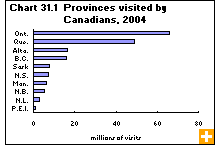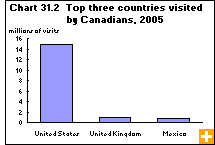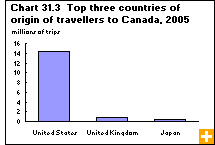Common menu bar links
Travel and tourism
Archived Content
Information identified as archived is provided for reference, research or recordkeeping purposes. It is not subject to the Government of Canada Web Standards and has not been altered or updated since it was archived. Please contact us to request a format other than those available.
Most Canadians are active travellers. Business people travel overseas frequently to buy and sell goods and services, Canadians regularly visit relatives in other parts of the world, and the backpacking tour of Europe or Australia is a tradition for thousands of students every year. For many of the same reasons, Canada has long been a popular destination for foreign tourists.
The Canadian dollar gained value against the American dollar and no major crises—such as the outbreak of severe acute respiratory syndrome (SARS) in 2003—arose to stall Canadians’ wanderlust in 2004. So they travelled more than the year before: this strengthened tourism by 2.6% with 216.9 million trips.
Yet Canadians vacationed closer to home in 2004. Four-fifths of those trips, or 175.1 million, were taken within the country. This marked a small recovery from 2003, when the number of trips taken in Canada dropped.
Domestic travellers boost tourism industry
The most popular destination for inter-provincial travel in 2004 was Ontario. Canadians made 65.2 million trips to Ontario, and 48.5 million trips to Quebec. Alberta and British Columbia, meanwhile, were the destination for close to 16 million trips. Nevertheless, intraprovincial travel—trips within one’s home province—accounted for almost 9 out of 10 domestic trips in 2004.
Travelling is significant for the economy—Canadians spent nearly $43 billion in 2005 on domestic travel, according to the National Tourism Indicators. Domestic spending was the only source of growth in the Canadian travel and tourism industry in 2005.
Canadian tourists boosted their travel spending in Canada by 5.9% in 2005, the largest annual gain since 2000. International visitors to Canada, meanwhile, spent slightly less while travelling here after a 9.0% increase in 2004. A downturn in visitors from the United States drove this decline, likely a result of the stronger loonie—it climbed 7.4% against the American dollar in 2005.
Airlines were the big winner in the travel industry in 2005, as spending on air transportation soared 8.6%, which accounted for one-third of the travel industry’s annual growth.
Other segments of the industry did not fare so well. Spending on fuel for vehicles rose only very slightly, as drivers were discouraged by higher prices at the gas pumps. Accommodation and food and beverage services also saw only slightly higher spending. And travel services companies were pinched by low-cost online travel bookings, though travel services spending increased 3.2%.
In 2005, the increase in domestic spending led travel and tourism’s gross domestic product to rise 4.0%—faster than the overall economy’s growth of 2.9%. The rise came on the heels of a similar gain the previous year. Employment in travel and tourism rose 1.7% to 626,000 jobs, the largest increase since 2000.
Canadians travelling abroad
Canadian residents made 44 million same-day and overnight trips abroad in 2005, spending $20.2 billion doing so. Almost half of these, or 21.1 million trips, were overnight trips outside the country. About 6.2 million of these overnight trips were to overseas destinations (not the United States), with more than half of them to Europe. Canadians spent $9.4 billion on overseas travel in 2005.
Still, Canadians’ top destination continues to be the United States—Canadians made nearly 15 million overnight visits and spent $9.5 billion there in 2005.
Their second most popular destination was the United Kingdom, with 898,000 overnight visits, followed by Mexico, with 794,000 visits. Rounding out Canadians’ top five international travel destinations were France, with 616,000 visits, and Cuba, with 518,000 visits.
Italy had the biggest jump in Canadian travellers in 2005, as visits there surged by half from the previous year.
Overnight travel to Asia totalled 1.1 million visits, up only 8.3% from 2004. Nevertheless, Canadian travel to Asia has soared 60.6% since 2000, possibly due to a rise in immigration to Canada from China and increased trade between the two countries.
Tourism to Canada
In 2005, non-resident visitors made 36 million same-day and overnight trips to Canada, spending $14 billion doing so. Following three consecutive declines, travel to Canada from overseas nations rose for a second year in a row.
Trips originating in the United States—the most important market for tourism to Canada—declined in 2005. Americans’ number of overnight trips fell 4.6% to 14.4 million, and they spent about $7.5 billion, 8.6% less than the year before.
The number of overnight trips to Canada from countries other than the United States increased 7.1% to 4.2 million trips. These overseas visitors spent $5.8 billion in Canada in 2005, up 7.0% from 2004.
The most important overseas market for tourism to Canada is still the United Kingdom. The number of trips to Canada from the United Kingdom in 2005 reached 888,000, a 10.8% gain from the previous year.
After the United States and the United Kingdom, the top countries of origin for travellers to Canada in 2005 were Japan, France and Germany. China had the largest annual percentage increase in 2005 among the top 12 markets for travel to Canada—Chinese residents made 113,000 trips here that year.





